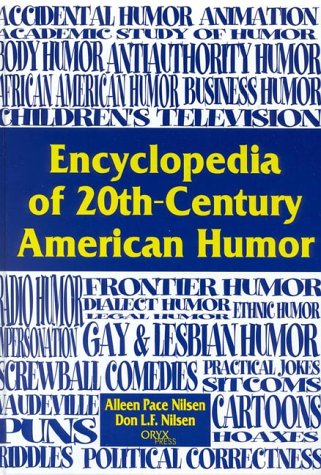The Nilsens have produced an interesting, erudite, and thorough Encyclopedia of 2Oth-Century American Humor with entries ranging from American Indian humor to cartoons, exaggeration, hoaxes, joke patterns, sitcoms, and wit. It is a truly comprehensive and encyclopedic volume with an excellent bibliography, a work that will become a standard reference not just in libraries but in the homes of those who love humor.
America exports not only film and television comedies but new genres of jokes. The riddling style of joke, the rebirth of the ethnic joke in the latter half of the 20th century, disaster and dead-celebrities jokes, lawyer jokes, and blonde jokes—all have been exported to the rest of the would, which has then copied and adapted them to local circumstances, while adding a dash of relevance and ingenuity. In the 20th century, American humor became an important cultural influence throughout the rest of the world: a process much accelerated by the internet.
And so it is not simply Americans who will appreciate this book. Nonetheless, many of the entries—blackface comedy, comic books, dialect humor, frontier humor, urban legends, and vaudeville—relate to distinctive aspects of the American cultural tradition. Curiously, the entry on irony in American humor is only just over a page long, much of it concerned with such celebrated Americans as George Bernard Shaw, Jonathan Swift, and Peter Sellers. The entry on wit is also very short. Section F begins with “Fiction,” and there is no entry on Feminist Humor,” perhaps because there’s no such thing. Jewish humor, however, gets a well-deserved five pages. (It is striking that Jews constitute a far greater proportion of comedy writers and comedians in America than they do of writers and actors in general.) A further useful aspect of the encyclopedia is its attention to humor scholarship—a branch of learning more developed in America than in any other country, even though it has its origins in Britain—as well as to concepts needed to understand humor better. There are, for instance, excellent sections on ambiguity, incongruity, language play, metaphor, and superiority as aspects of how humor works.
While the 20th century was a great one for American humor, it produced two forces that now threaten not only comedy but American culture in general: dumbing-down and political correctness. The importation from England of the Teletubbies, which are bound to stultify and retard children’s progress in mastering language and concepts, is a good example of both of these forces in action. The obviously gay Teletubbies are England’s triangular revenge for Disney’s vulgarization of Winnie the Pooh. The original by A.A. Milne is a sophisticated book for adults as well as children; the Disney film is simply a means to sell cuddly toys. The problem lies with the publishers of juvenile books, staffed as they are by over-cautious, category-bound old women of both sexes devoted to dumbing-down and political correctness alike. These businesses, moreover, are not even commercially successful: Most of their income comes from the reprinting of old favorites. (Over 40 houses turned down the money-spinning Harry Potter before it found a publisher.) No wonder the Nilsens’ entry on children’s literature consists largely of lists of older books and summaries of their plots.
Inevitably, the text includes a number of references to the rise of political correctness in America, from which an outsider concludes that the results have been censorship, the cramping of creativity, and a suffocating climate of fear. Indeed, most of the best American humor of the 20th century could not have originated—let alone been published or broadcast—during the 1990’s. (Another exuberant, aggressive, exciting American frontier is closing.) Accordingly, the Nilsens’ encyclopedia is rich in press accounts of p.c. incidents such as the harassment of, and near assault on, John O’Sullivan when he visited Yale to justify National Review‘s mockery of the Clinton-Gore administration’s attempts to raise campaign contributions from Chinese businessmen by publishing a cartoon that portrayed members of Clinton’s Cabinet with Chinese features. The Chinese themselves did not object, but the Yale vigilantes turned up with placards, spouting abuse and striking at one of America’s most prominent editors. Another account tells of Mohamoud M. Ismail, a sociology professor at Trenton State College who, in 1995, sued two colleagues for collecting and distributing teaching material in the form of cartoons that he found offensive to blacks.
The Nilsens must have the best library in America of newspaper cuttings and internet downloads on their subject. All the humor that is fit to print can be found here, plus a good deal that isn’t.
[Encyclopedia of 20th-century American Humor, Alleen Pace Nilsen and Don Nilsen (Phoenix: Oryx Press) 360 pp., $79.75]

Leave a Reply